I'M HERE AT KAMISETAWednesday, October 18, 2006 Around 6 months of age your baby’s iron stores will become depleted and you should be introducing foods rich in iron. Start with an iron-fortified infant rice cereal. Rice cereal is the food least likely to cause an allergic reaction. After about a week, you can move on to other cereals such as barley or oats. Feed cereal after breastfeeding or formula feeding. Once things are going well with cereal, you can begin to add other foods such as vegetables and fruit. Offer them separately. Begin with pureed vegetables, like sweet potatoes, squash or peas and fruit like apples, peaches or pears. They should be smooth and easy to chew and swallow. Around 6 months of age your baby’s iron stores will become depleted and you should be introducing foods rich in iron. Start with an iron-fortified infant rice cereal. Rice cereal is the food least likely to cause an allergic reaction. After about a week, you can move on to other cereals such as barley or oats. Feed cereal after breastfeeding or formula feeding. Once things are going well with cereal, you can begin to add other foods such as vegetables and fruit. Offer them separately. Begin with pureed vegetables, like sweet potatoes, squash or peas and fruit like apples, peaches or pears. They should be smooth and easy to chew and swallow.Remember: Breast milk or infant formula should remain the main food for the first year. Cautions! Do not use honey until 1 year to prevent botulism (a form of food poisoning). Do not use egg whites until 1 year to minimize any possible allergic reaction (but egg yolks are okay at 6 months). Do not use raw eggs. To prevent salmonella poisoning cook all eggs well. Do not add sugar or salt to your baby's food. Instead, let him enjoy the natural tastes of food. If warming baby food, stir and test before feeding to make sure it is not too hot. 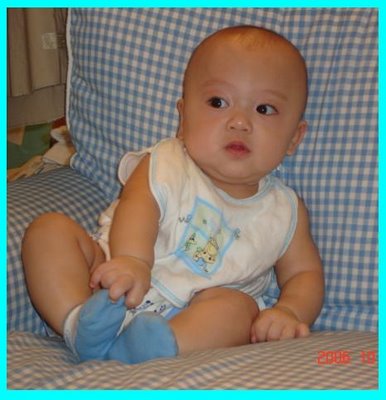 Using a cup When your baby is about 6 to 9 months old, he may be ready to try drinking from a cup. Start with a covered cup with a spout. Give him time to master this new skill. Then you can give him a regular cup to try. Lots of variety Try to give him as much variety in his diet as you can to help him form good eating habits. Offer lots of different flavours and a variety of interesting colors and shapes. There probably will be some new foods that he seems not to like. Be sure to continue offering them to him. He may grow to like them. A lifetime of healthy eating. As you help your little one make the transition to solids, you are also helping him form good eating habits. So choose carefully the foods you feed him. Don't forget that children are natural mimics. You'll want to be a good role model and eat your greens, too. Try to monitor your baby's eating habits without setting too many limitations. To help yourself stay even-keeled, talk to your doctor about the normal course of growth. So you know what kind of ups and downs to expect. Don't connect food to approval or comfort, or you could establish a pattern of emotional eating that will last for years to come. Restricting food too much can cause a child to become nervous about its availability and to overeat. 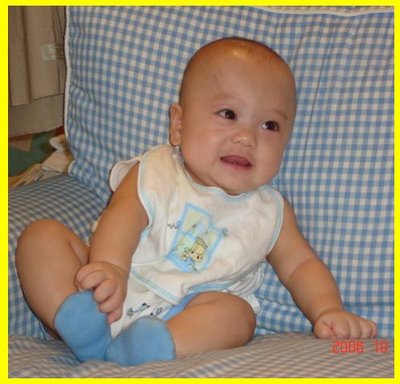 At six months your baby may: Sensory / Intellectualbegin to use subtle hand and arm gestures to communicate Languagesit by herself Social /Emotionalstart mimicking your behaviour Learning to Communicate Amazingly, this month your baby may reach and gesture with her hands. It might be her way of imitating you or trying to tell you something. But you probably won't notice it. Her communication skills need lots of work. You're not used to having a baby who says "Give me", even if it's only with her hands. Watch your six-month-old closely. You'll see she sometimes tries to use gestures, body language and eye contact to get her point across. She will also start babbling this month. By paying closer attention to adult speech, she is able to make sentence-like strings of vowels and consonants. It's up to you to guess what she means when she says "Ba ba ba" or "Da la da la." Sitting Up Sitting up takes a combination of strength, balance and coordination. Your baby will probably start with a tripod pose. That means she'll keep her hands on the floor between her legs. Gradually, she'll learn to sit up straight and let go of the floor. By the end of the month, she'll actually play in this position. Monkey See, Monkey Do At six months, babies begin to imitate others. Your baby wants to be like you. Open your mouth and your little monkey will open hers, too. Bang a toy, shake a rattle, splash the bath water, and with a little encouragement, she'll delight in following your lead.  At six months, babies begin the steps towards mastering some major skills: from sitting up, to crawling and standing. All this mobility and coordination will bring a sense of independence, and some frustration. Build on your baby's more developed physical control by sitting him up, unsupported. Surround him with pillows to cushion his tumbles and rolls. Of course, always keep an eye on him. Lay your baby on his stomach and lift his legs a few inches off the floor. Encourage him to push his upper body off the floor with his arms. Sing nursery rhymes pronouncing the words clearly, and varying the loudness of your voice. Rhymes help babies build up their sound repertoires and early reading readiness. Clap your baby's hands together while you sing to him. Stand where your baby can see you, and tell him you're going to pick him up. Hold out your arms. When he smiles, coos, or reaches for you, pick him up. 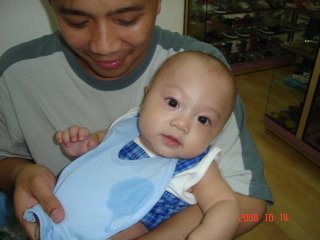 My mom bought me a new bib kc naubusan na ako and at the same time it's so fun for me na ngatngatin . Maybe I changed 5 alredy!!!! By the way I met 3 girls here!! pogi ko daw My mom bought me a new bib kc naubusan na ako and at the same time it's so fun for me na ngatngatin . Maybe I changed 5 alredy!!!! By the way I met 3 girls here!! pogi ko daw Paging Rusty Lopez, size 6, brown color, please hurry so the customer will not worry!! Paging Rusty Lopez, size 6, brown color, please hurry so the customer will not worry!!
 This is my new bumpin car!! This is my new bumpin car!!
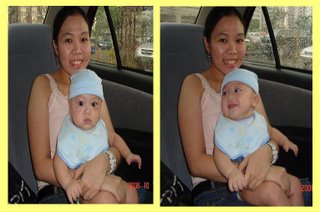 Just another rainy day, just another phone call away!!! Just another rainy day, just another phone call away!!!STROLLER KO PO ITO!!!! Last Sunday, my whole family went to G4, para maglibang at mamasyal kasi sobrang bored na sa bahay. While we were walking, we saw nice baby store beside oshkosh bgosh. A stroller, na sobrang bagay kay joshua koykoy kc everytime we go out we always carry him especially kuya rain and we know nakakangawit na rin sa likod ang pagkarga, kaya we decided to buy na lang. As in ayaw ng umalis ni joshua sa kanyang baging stroller, we bought in a reasonable prices compare to graco na super expensive talaga and to think after a year sa bodega lang mapupunta ang gamit na ito. But, anyway, cute talaga ng baby na ito!!!mwah!!mwah!!! Strollers and Baby Carriages Children outgrow baby carriages quickly. That's why convertible carriages/strollers have become popular. When choosing a carriage/stroller, get one with a wide base to minimize the risk of it tipping over. If there's a basket attached to the stroller, it should be low and near the wheels for better balance. Make sure the model you choose has easy-to-operate brakes on the wheels. Once you choose a stroller or carriage, read the manual carefully. Of course you know never to leave your baby unattended. Consider these guidelines for safe usage of a stroller: Always secure your baby with the seat belt and harness. When you're opening or closing a collapsible stroller, it's best to keep your baby away from it so his fingers don't get caught in the hinges. If you use a collapsible stroller, be sure your baby can't reach the release lever when you're stopped. Use the carrying basket instead of hanging diaper or shopping bags on the handles. That could make the stroller tip over. 6th month Baby DevelopmentBody Movement Lifts chest and most of tummy off floor by pushing up on extended arms. Rolls from back to tummy easily. Rocks and kicks a lot. Rolls around in delight. Sits erect briefly, using hands on floor for balance and support. Bounces when held erect. Likes seeing the world when standing. Thinking Skills Follows your direction of pointing. May point at new things. Babbles and "talks" to toys and to himself in mirror. Intently listens to his own voice. Understands your speech by the tone of your voice. Recognizes names, basic words, familiar household sounds. Enjoys manipulating other people's faces by poking, pulling and studying them to understand his separateness from them. Emotional Development Very sociable -- smiles, laughs hilariously and enjoys being with people. May be more selective about with whom she socializes. When she can't do something, may become frustrated, whine or explode in rage. Smiles at herself in the mirror (but does not recognize it is her reflection until she is more than one year old). Is very curious to explore the world around her. Plays by herself longer because she can sit better now. Appears to make decisions when choosing to play with toys. Enfapro A+Monday, October 16, 2006 Enfapro A+ contains added DHA and ARA (Omega 3 & 6 fats), nutrients naturally found in breastmilk, to help support brain and eye development. Both formulas are iron fortified and contain more calcium than other formulas to help build strong bones and teeth.Enfapro A+ has more calcium than Enfamil A+, to help build strong bones and teeth. Enfamil A+ and Enfapro A+ both contain DHA and ARA (Omega 3 & 6 fats), nutrients naturally found in breast milk, to help support brain and eye development. Enfapro A+ is a calcium enriched milk based formula for babies six months of age and older that has been specially formulated to fulfill your baby's changing nutritional needs. It contains DHA and ARA (Omega 3 & 6 fats) nutrients naturally found in breast milk, to help support brain and eye development. The Canadian Paediatric Society recommends that cow's milk not be introduced before 9 to 12 months of age. Enfapro A+ is gentler on your baby's digestive system than cow's milk and helps make the transition from breast milk or formula to cow's milk easier. Enfapro A+ contains added DHA and ARA (Omega 3 & 6 fats), nutrients naturally found in breastmilk, to help support brain and eye development. Both formulas are iron fortified and contain more calcium than other formulas to help build strong bones and teeth.Enfapro A+ has more calcium than Enfamil A+, to help build strong bones and teeth. Enfamil A+ and Enfapro A+ both contain DHA and ARA (Omega 3 & 6 fats), nutrients naturally found in breast milk, to help support brain and eye development. Enfapro A+ is a calcium enriched milk based formula for babies six months of age and older that has been specially formulated to fulfill your baby's changing nutritional needs. It contains DHA and ARA (Omega 3 & 6 fats) nutrients naturally found in breast milk, to help support brain and eye development. The Canadian Paediatric Society recommends that cow's milk not be introduced before 9 to 12 months of age. Enfapro A+ is gentler on your baby's digestive system than cow's milk and helps make the transition from breast milk or formula to cow's milk easier. There are 6 Nutrition on which Baby Joshua Needed: 1.) CALCIUM - Your baby's essential calcium deposits will be created almost entirely during childhood and young adulthood, while his bones are still growing and mineralizing. Calcium’s main role is to mineralize and develop bones, it is also crucial in blood clotting, muscle contraction and nerve transmission. 2.) FATS - Babies need fat. Fat is a great source of energy. Babies’ tummies are so small they need a very concentrated source of energy to support their rapid growth. Fat provides energy and essential vitamins. Fats are also very important to your baby for brain and nervous system development. Your baby uses fats, such as DHA and ARA (Omega 3 & 6 fats), to form the membranes of all new cells in his body. Your baby's brain is more than 60% fat. And the fat he gets will help the brain triple in size by the end of the first year. 3.) IRON - is a factor in red blood cell formation. Iron helps carry oxygen to all parts of the body to allow for growth and movement. Too little iron can lead to iron deficiency anemia which causes tiredness, irritability and a low attention span. In children, low iron levels can lead to a reduced ability to learn and depressed growth. Babies and young children grow much more rapidly than adults, therefore iron is even more essential for them during this crucial stage.Up to the age of 6 months, babies who are exclusively breastfed will receive enough iron from breast milk. For formula fed babies, the Canadian Paediatric Society recommends they be given an iron-fortified formula from birth. Iron-fortified formula, in combination with a baby's internal iron stores, ensures that they receive enough iron during the first 6 months. After that time, breast milk or iron-fortified formula, combined with solid foods high in iron, ensures that your baby receives the necessary iron up until one year. 4.) FLUORIDE - is a naturally occurring substance that is proven to protect teeth.When teeth are in direct contact with fluoride it strengthens the tooth enamel making it more resistant to cavities and decay. If fluoride is consumed when baby’s teeth are developing, it will circulate through the bloodstream and get built into the tooth enamel while it forms.In many communities across Canada, fluoride is added to the municipal water. But if there's less fluoride in the water than 0.3 parts per million, like in most areas of Quebec, the Canadian Paediatric Society recommends that you talk to your dentist or other health professional about a fluoride supplement, like Tri-Vi-Sol with Fluoride. If you're not sure if your main water supply is fluoridated, you can call your municipal office to find out.Check with your baby’s dentist or doctor to make sure your baby is getting the right level of fluoride. 5.) VITAMIN D - Breast milk is the best nutrition for your baby. But did you know that it might contain only 15 to 40 I.U. (International Units) of vitamin D per liter? That’s a mere 10% of the recommended daily intake. Important organizations like the Canadian Paediatric Society, Dietitians of Canada, and Health Canada jointly recommend that all breastfed, healthy term babies in Canada receive a daily vitamin D supplement of 400 I.U. Health Canada recommends, if you are breastfeeding, that you begin giving your baby a vitamin D supplement at birth and continue until they are one year old or until they get 400 I.U. of Vitamin D from their diet. 6.) WATER - When babies are fed breast milk or fed infant formula as their sole source of nutrition, they normally do not need extra water. The fluid they get at feedings provides their bodies with all the water they require. When babies start solid foods, your doctor may suggest adding drinking water to their diet. Cerelac......Sunday, October 15, 2006 Since, Baby Joshua will turning 6 months tomorrow. He's going to start eating cerelac (rice & soya). Rice is a rich source of methionine, and soya is a rich source of lysine, both essentials proteins needed for baby's growth. Soya also contains fiber, starting baby on the health habit of including fiber in his baby daily diet. It also said that cerelac supports optimal growth during the critical period of rapid growth and development. It plays an important role in providing enough energy, proteins, vitamins, and minerals. It is a complete meal which delivers 20-30% of his daily nutritional requirements. At this stage Baby Joshua will now starts sits in a high chair, starts to crawl, turns his head towards sounds and picks up objects and puts them into his mouth. The preparation of this are the ff: A) Wash your hands before preparing Baby's food. Make sure all utensils are thouroughly clean. B) Boil clean drinking water for 5 minutes and allow to cool. C) Measure 150 ml water and 50g or 5tbsp. of cerelac into baby's bowl. D) Stir until the pap is smooth and feed your baby with a clean spoon. Since, Baby Joshua will turning 6 months tomorrow. He's going to start eating cerelac (rice & soya). Rice is a rich source of methionine, and soya is a rich source of lysine, both essentials proteins needed for baby's growth. Soya also contains fiber, starting baby on the health habit of including fiber in his baby daily diet. It also said that cerelac supports optimal growth during the critical period of rapid growth and development. It plays an important role in providing enough energy, proteins, vitamins, and minerals. It is a complete meal which delivers 20-30% of his daily nutritional requirements. At this stage Baby Joshua will now starts sits in a high chair, starts to crawl, turns his head towards sounds and picks up objects and puts them into his mouth. The preparation of this are the ff: A) Wash your hands before preparing Baby's food. Make sure all utensils are thouroughly clean. B) Boil clean drinking water for 5 minutes and allow to cool. C) Measure 150 ml water and 50g or 5tbsp. of cerelac into baby's bowl. D) Stir until the pap is smooth and feed your baby with a clean spoon. BEEP!!!BEEP!!!Tuesday, October 10, 2006Sunday, October 08, 2006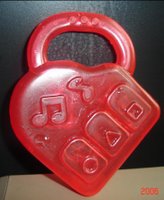 This is my Pigeon Cooling Teether, Joshua always bite this. It stimulates development of joshua's mouth and fingers. Ideal shape for baby to chew and grasp. Babies like to put things in their mouths, this is a natural reflex, part of their development. But sometimes, babies may also experience the discomfort of teething. As a mother, I believed that the Pigeon Cooling Teeter will give my joshua something satisfying to chew on. The handle is designed so that it is easy for baby to hold. This teether has been filled with fully tested, sterilised water and absolutely safe.  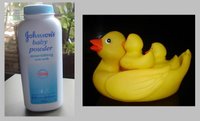 Last week, I went to SM Makati (Baby Section) Since, my son is 6 months na, I decided to buy a Johnson's Baby Powder na napakabango talaga and his cute yellow ducky para sa kanyang pagligo, para naman he could hold and grasp at the same time. Tuwang tuwa naman siya, especially kapag pininidut niya ang kanyang mga ducky. he!!!! he!!!!!. This Pigeon Breast pump naman ay very convenient, but unfortunately, I'm not that confortable with this kasi mas prefer ko talaga yung natural way and at the same time it's very complicated. I believed that this Breast pump is advisable for working mom especially during the absences to your baby. Last week, I went to SM Makati (Baby Section) Since, my son is 6 months na, I decided to buy a Johnson's Baby Powder na napakabango talaga and his cute yellow ducky para sa kanyang pagligo, para naman he could hold and grasp at the same time. Tuwang tuwa naman siya, especially kapag pininidut niya ang kanyang mga ducky. he!!!! he!!!!!. This Pigeon Breast pump naman ay very convenient, but unfortunately, I'm not that confortable with this kasi mas prefer ko talaga yung natural way and at the same time it's very complicated. I believed that this Breast pump is advisable for working mom especially during the absences to your baby. This is my fairytales books which includes: Peter and the Wolf, The Sly Fox and the Little Red Hen, The Wolf and the Seven Little Kids, The Three Little Pigs, Thumbelina, Hansel and Gretel and Little Riding Hood. This is my fairytales books which includes: Peter and the Wolf, The Sly Fox and the Little Red Hen, The Wolf and the Seven Little Kids, The Three Little Pigs, Thumbelina, Hansel and Gretel and Little Riding Hood. What a great story! My favoriite was The Three Little pigs, HE!HE!HE! This is my first educational flashcards which includes mammals and reptiles, shapes and colors, animal kingdom and the most important is the alphabet and the numbers. Everyday, me and my mom review this things. |
|||
|